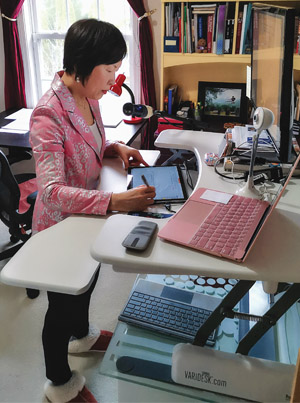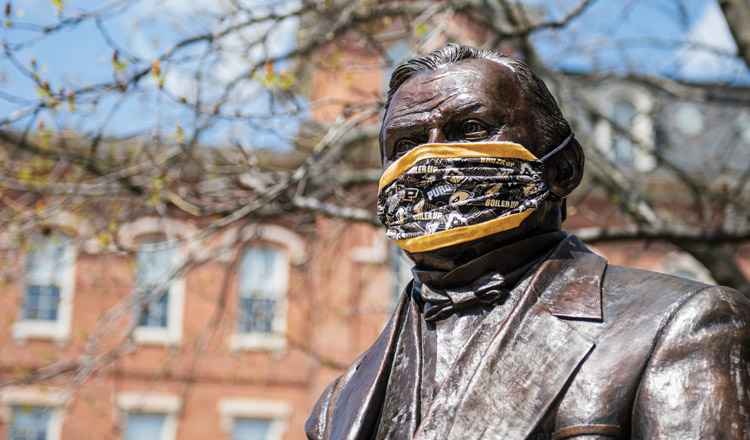Faculty Perspectives

Supported by the Innovative Learning team, Information Technology at Purdue, and the Center for Instructional Excellence, faculty transitioned 5,000 courses to an online format over two weeks. Classes resumed on March 23, following spring break, and students began attending virtually.
Hong Tan, professor of electrical and computer engineering, taught her first day of virtual classes in her slippers (right).
“It was an emotional journey to move my classes online. First, panic — how do I deliver lectures online and record it, too? Then, hopelessness — nothing worked. My tablet stylus needed a new battery, my microphone didn’t work with Webex, and I had no idea where the recorded lecture video lived on the cloud. With practice over spring break, things slowly but surely fell into place. By the first day of teaching from home, I looked forward to seeing my students again. I decided to dress up to get myself in the mood to teach. The online lecture went well, although I was nervous and soaked in sweat.
“The students have been incredible. Many told me that the lecture went fine, and they were able to follow the materials presented. They appreciated having access to the recorded video. Online office hours remain a challenge. I am used to looking at a student’s circuit diagrams and guiding them through calculations. This is difficult on Webex — something we must figure out together.”
The second half of Jarred Brooke’s (A’12) fire ecology class typically involves fieldwork. The wildlife specialist in the Department of Forestry and Natural Resources quickly adapted a rigorous four weeks in the field to an online environment.
“I put out a call on Twitter to all the people I know who work with prescribed fire, looking for anything I could use in class. I received resources from across the United States plus a few different countries. One benefit of going online is that I can break the material into smaller chunks and give quizzes to reinforce those concepts. This experience will change how I teach the course in the future. The online resources I’ve created will be used as supplemental material to the fieldwork and to better prepare students. More abstractly, this entire process made me think more critically about how to better put into words what happens during a prescribed burn and how we should be talking about it in the field.”
Mark Zimpfer (MS T’16), assistant professor of practice in the Polytechnic Institute, says his initial feeling of panic quickly turned to excitement. He turned to home makeover shows to provide material for studying residential construction practices for his advanced pre-construction management course.
“It was a challenge. When you have 30 years in the construction industry, you can say, ‘OK, this is like a construction problem. We had a plan, it changed, so how are we going to react?’ There’s a massive quantity of instructional material available in these shows. It is excellent visual material, and it demonstrates construction around the world, both good and bad. I have students write down things they would do differently — code violations or safety violations. It’s a great tool to let the student watch a jobsite critically and pick things apart, to analyze.”

